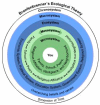Putting Children's Sleep Problems to Bed: Using Behavior Change Theory to Increase the Success of Children's Sleep Education Programs and Contribute to Healthy Development
- PMID: 27417249
- PMCID: PMC5039471
- DOI: 10.3390/children3030011
Putting Children's Sleep Problems to Bed: Using Behavior Change Theory to Increase the Success of Children's Sleep Education Programs and Contribute to Healthy Development
Abstract
Sleep is critical for the healthy development of children, yet most children simply don't get enough. Whilst school based sleep education programs have been developed for parents and their children, they have had mixed success. We consider how use of behavior change theory in existing school-based sleep education programs can be improved by applying and apply a broader model to these programs. We find that the mixed success of school-based sleep education programs may be due to a plausible but misleading assumption that simply increasing information about the importance of sleep and the risks of insufficient and/or inefficient sleep will necessarily result in improved sleep behaviors. We identify the potential benefits of using behavior change theory in the development of sleep education programs but in particular, there is a need for theories incorporate the multiple biological, environmental and social impacts on children's sleep. Bronfenbrenner's Bioecological model is presented to illustrate how one such behavior change theory could significantly improve the success of sleep education programs and ultimately support the healthy development of children.
Keywords: behaviour theory; children’s sleep; prevention; sleep education.
Conflict of interest statement
The authors declare no conflict of interest.
Figures
Similar articles
-
A family-based approach to the prevention of depressive symptoms in children at risk: evidence of parental and child change.Pediatrics. 2003 Aug;112(2):e119-31. doi: 10.1542/peds.112.2.e119. Pediatrics. 2003. PMID: 12897317 Clinical Trial.
-
Environmental and behavioural factors associated with school children's sleep in Aotearoa/New Zealand.J Paediatr Child Health. 2017 Jan;53(1):68-74. doi: 10.1111/jpc.13268. Epub 2016 Sep 1. J Paediatr Child Health. 2017. PMID: 27586066
-
Farm to Preschool Programs and Its Impact on Children's Dietary Health: Evaluation Through Bronfenbrenner's Socio-Ecological Model.Ecol Food Nutr. 2024 May-Jun;63(3):191-203. doi: 10.1080/03670244.2024.2327619. Epub 2024 Mar 8. Ecol Food Nutr. 2024. PMID: 38456668 Review.
-
Children's questions: a mechanism for cognitive development.Monogr Soc Res Child Dev. 2007;72(1):vii-ix, 1-112; discussion 113-26. doi: 10.1111/j.1540-5834.2007.00412.x. Monogr Soc Res Child Dev. 2007. PMID: 17394580
-
Determining factors of child linear growth from the viewpoint of Bronfenbrenner's Bioecological Theory.J Pediatr (Rio J). 2023 May-Jun;99(3):205-218. doi: 10.1016/j.jped.2022.10.009. Epub 2022 Dec 23. J Pediatr (Rio J). 2023. PMID: 36572387 Free PMC article. Review.
Cited by
-
Healthy sleep for healthy schools: A pilot study of a sleep education resource to improve adolescent sleep.Health Promot J Austr. 2022 Oct;33 Suppl 1(Suppl 1):379-389. doi: 10.1002/hpja.594. Epub 2022 Mar 17. Health Promot J Austr. 2022. PMID: 35266233 Free PMC article.
-
The missing link between sleep disorders and age-related dementia: recent evidence and plausible mechanisms.J Neural Transm (Vienna). 2017 May;124(5):559-568. doi: 10.1007/s00702-017-1696-9. Epub 2017 Feb 10. J Neural Transm (Vienna). 2017. PMID: 28188439 Review.
-
A Pilot Randomized Control Trial Demonstrating the Efficacy of the SIESTA Sleep Hygiene Intervention.Clin Pediatr (Phila). 2024 Sep;63(8):1062-1077. doi: 10.1177/00099228231207307. Epub 2023 Oct 31. Clin Pediatr (Phila). 2024. PMID: 37905528 Free PMC article. Clinical Trial.
References
-
- Samson R., Blunden S., Banks S. The characteristics of sleep and sleep loss in adolescence: A review. Int. Rev. Soc. Sci. Humanit. 2013;4:90–107.
-
- Kjeldsen J.S., Hjorth M.F., Andersen R., Michaelsen K.F., Tetens I., Astrup A., Chaput J.-P., Sjödin A. Short sleep duration and large variability in sleep duration are independently associated with dietary risk factors for obesity in Danish school children. Int. J. Obes. 2014;38:32–39. doi: 10.1038/ijo.2013.147. - DOI - PubMed
Publication types
LinkOut - more resources
Full Text Sources
Other Literature Sources



